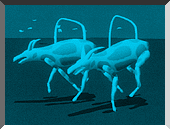
A Virtual Experience






"We know how an animal moves, not just what it looks like. In our computer simulations of virtual animals, the geometric representations are deliberately designed to be simple in order to emphasize the motion of the animals, rather than the details of their appearance. For us, the essential expression is in the abstraction of the motion, and what it suggests to the imagination of the viewer.The motion of the animals is modeled with computer programs that simulate the physical qualities of movement. many of the techniques employed are inspired by the robotics field. Legged animals respond to simulated gravity as they walk and run in various gaits. They are able to spontaneously plan footholds on the ground so that they appear to be dynamically balanced. Birds and other flying creatures accelerate when flapping their wings and bank realistically into turns. Flocking and herding algorithms direct the patterns of flow for large groups of animals.
All animals maintain a degree of autonomy as they adaptively alter their motion in response to their surroundings, avoiding collisions with both other animals and the Virtual Environment user. Animals may follow general goals, such as "walk along any path from door X to door Y" or "fly toward region Z and land on any unoccupied spot on the ground". However, their precise movements are unpredictable since they depend on the constantly shifting circumstances of interaction between each of the animals and the user."
All contents copyright (C) 1995 Telepresence Research, Inc. All rights reserved Revised: 2-20-95